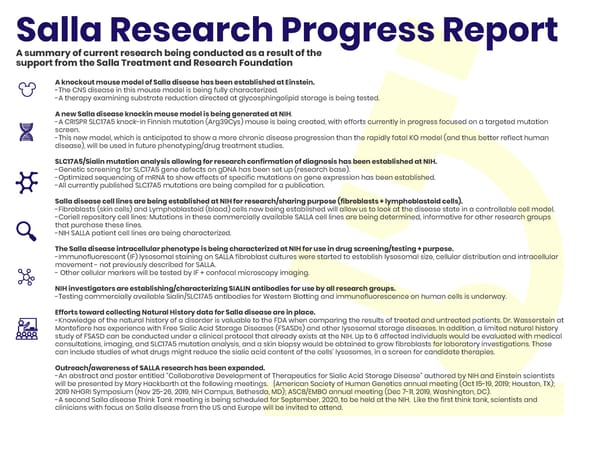Salla Research Progress Report A summary of current research being conducted as a result of the support from the Salla Treatment and Research Foundation A knockout mouse model of Salla disease has been established at Einstein. -The CNS disease in this mouse model is being fully characterized. -A therapy examining substrate reduction directed at glycosphingolipid storage is being tested. A new Salla disease knockin mouse model is being generated at NIH. -A CRISPR SLC17A5 knock-in Finnish mutation (Arg39Cys) mouse is being created, with efforts currently in progress focused on a targeted mutation screen. -This new model, which is anticipated to show a more chronic disease progression than the rapidly fatal KO model (and thus better reflect human disease), will be used in future phenotyping/drug treatment studies. SLC17A5/Sialin mutation analysis allowing for research confirmation of diagnosis has been established at NIH. -Genetic screening for SLC17A5 gene defects on gDNA has been set up (research base). -Optimized sequencing of mRNA to show effects of specific mutations on gene expression has been established. -All currently published SLC17A5 mutations are being compiled for a publication. Salla disease cell lines are being established at NIH for research/sharing purpose (fibroblasts + lymphoblastoid cells). -Fibroblasts (skin cells) and Lymphoblastoid (blood) cells now being established will allow us to look at the disease state in a controllable cell model. -Coriell repository cell lines: Mutations in these commercially available SALLA cell lines are being determined, informative for other research groups that purchase these lines. -NIH SALLA patient cell lines are being characterized. The Salla disease intracellular phenotype is being characterized at NIH for use in drug screening/testing + purpose. -Immunofluorescent (IF) lysosomal staining on SALLA fibroblast cultures were started to establish lysosomal size, cellular distribution and intracellular movement - not previously described for SALLA. - Other cellular markers will be tested by IF + confocal microscopy imaging. NIH investigators are establishing/characterizing SIALIN antibodies for use by all research groups. -Testing commercially available Sialin/SLC17A5 antibodies for Western Blotting and immunofluorescence on human cells is underway. Efforts toward collecting Natural History data for Salla disease are in place. -Knowledge of the natural history of a disorder is valuable to the FDA when comparing the results of treated and untreated patients. Dr. Wasserstein at Montefiore has experience with Free Sialic Acid Storage Diseases (FSASDs) and other lysosomal storage diseases. In addition, a limited natural history study of FSASD can be conducted under a clinical protocol that already exists at the NIH. Up to 6 affected individuals would be evaluated with medical consultations, imaging, and SLC17A5 mutation analysis, and a skin biopsy would be obtained to grow fibroblasts for laboratory investigations. Those can include studies of what drugs might reduce the sialic acid content of the cells’ lysosomes, in a screen for candidate therapies. Outreach/awareness of SALLA research has been expanded. -An abstract and poster entitled “Collaborative Development of Therapeutics for Sialic Acid Storage Disease” authored by NIH and Einstein scientists will be presented by Mary Hackbarth at the following meetings. {American Society of Human Genetics annual meeting (Oct 15-19, 2019; Houston, TX); 2019 NHGRI Symposium (Nov 25-26, 2019, NIH Campus, Bethesda, MD); ASCB/EMBO annual meeting (Dec 7-11, 2019, Washington, DC). -A second Salla disease Think Tank meeting is being scheduled for September, 2020, to be held at the NIH. Like the first think tank, scientists and clinicians with focus on Salla disease from the US and Europe will be invited to attend.
 2018-2019 progress report Page 7 Page 9
2018-2019 progress report Page 7 Page 9